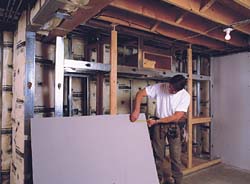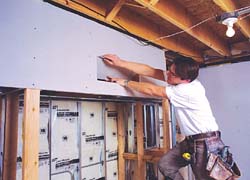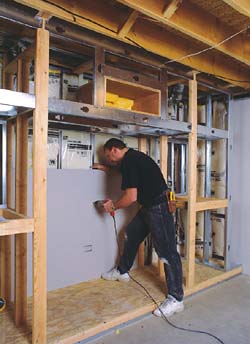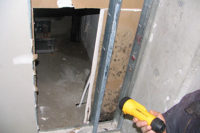Specifically, the following will help contractors develop a better understanding of the construction environment, moisture and mold, and how building materials are affected by it.

Question:
Why am I suddenly hearing so much about mold and mildew?Answer:
There has been a heightened focus on this subject in the media, largely due to some high-profile litigation related to mold buildup and remediation. It has certainly brought more focused attention on builders and trades, who are being asked to more carefully watch for ways to prevent moisture from entering the building envelope. Mold cannot grow without the presence of moisture, which is the true-yet preventable-culprit in this equation.Question:
What are the most common sources of moisture on the job site?Answer:
Sources of moisture typically can include wet building materials, leaks in the building envelope itself or its plumbing system, HVAC condensation or even minor flooding.Question:
When is moisture most likely to enter the building?Answer:
The great majority of moisture problems occur during the actual construction phase, when materials can be installed improperly. Also, an accelerated construction schedule can force the contractor to begin installing materials before the envelope has been properly protected from moisture and the elements. Faulty HVAC systems and improper design are two other common sources of moisture.Question:
Do most building materials support the growth of mold and mildew?Answer:
Mold and mildew grow in or on virtually every construction or building material currently in use. Given the right conditions, almost any material can be overwhelmed by mold; even aluminum, steel and glass will support mold growth under the right conditions.
Question:
What conditions are necessary for mold to grow?Answer:
Water, mold spores and a food source must be present. Since spores waft about nearly constantly and building materials (the food source) are obviously present, the only truly controllable factor is moisture.Question:
Can mold affect your health?Answer:
The vast majority of molds are not harmful to healthy individuals; in fact, many varieties of molds are healthy in nature. However, excessive exposure to certain molds may cause or worsen conditions such as asthma, hay fever or other allergies.Question:
Is there a simple, "common sense" approach to avoiding mold growth?Answer:
Control the moisture that can result in mold formation. This requires careful design, proper construction techniques and thorough inspections and maintenance throughout the life span of a building. This means that architects, designers, contractors and maintenance engineers must work more closely together than ever.
Question:
What about using "moisture resistant" building materials?Answer:
Some manufacturers have products that will resist moisture and mold growth. However, one must realize that moisture is not simply a product issue, but a building systems issue. As such, moisture control must be viewed in the same way issues such as fire resistance, sound control, abuse resistance and aesthetics are addressed. Products alone will not mitigate any major problem.Question:
What is the best way to tell if there is a mold problem?Answer:
Contact a local building inspector and ask about their mold testing and remediation services. They can be of help in assessing your problem and either providing a remedy or recommending someone who can clean it up.Question:
Where can I find good, unbiased reference material on this subject?Answer:
The EPA (www.epa.gov) is a resource on this subject.The following questions and answers are excerpted with permission from the New York City Department of Health:
What are molds? Molds produce tiny spores to reproduce. Mold spores waft through the indoor and outdoor air continually. When mold spores land on a damp spot indoors, they may begin growing and digesting whatever they are growing on in order to survive. There are molds that can grow on wood, paper, carpet and foods. When excessive moisture or water accumulates indoors, mold growth will often occur, particularly if the moisture problem remains undiscovered or not addressed. There is no practical way to eliminate all mold spores in the indoor environment; the way to control indoor mold growth is to control moisture.1How does mold grow? All molds need water to grow. Mold can grow almost anywhere there is water damage, high humidity or dampness. Most often molds are confined to areas near the source of water. Removing the source of moisture-such as through repairs or dehumidification-is critical to preventing mold growth.
What should be done if mold is present? Although any visible mold can be sampled by an environmental consultant and/or analyzed by a laboratory specializing in microbiology, these tests can be very expensive-from hundreds to thousands of dollars. There is no simple and cheap way to sample the air in a building to find out what types of mold are present and whether they are airborne. Even if the building has been tested, it is difficult to say at what levels health effects would occur. Therefore, it is more important to eliminate the mold rather than find out more about it. The most effective way to treat mold is to correct underlying water damage and clean the affected area.
How should mold be cleaned? Mold should be cleaned as soon as it appears. Persons cleaning mold should not be prone to allergies. Small areas of mold should be cleaned using a detergent/ soapy solution or an appropriate household cleaner. Gloves should be worn during cleaning. The cleaned area should then be thoroughly dried. Dispose of any sponges or rags used to clean mold.
If the mold returns quickly or spreads, it may indicate an underlying problem such as a leak. Any underlying water problems must be fixed to successfully eliminate mold problems. If mold contamination is extensive, a professional abatement company may need to be consulted.
Who should be called if there is a suspected mold problem or if more information is needed? For more information about the health effects of mold exposure and information on the safe removal of mold, call the New York City Department of Health, Office of Environmental Investigations at (212) 442-3372 or the Environmental and Occupational Disease Epidemiology Unit at (212) 788-4290.
Footnotes
1. U.S. Environmental Protection Agency, www.epa.gov


Report Abusive Comment